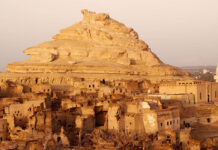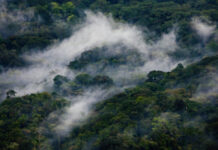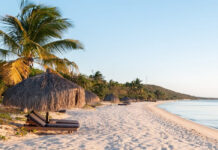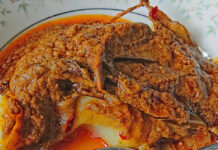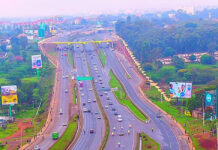Eastern Ethiopia
In 1974 the 3.5 million years old remains of the ancestral Australopithecus Afarensis were found in the Hadar area of Ethiopia, and nicknamed ‘Lucy’. This is only one of the many major scientific discoveries in the area; only twenty years later, in 1994, the scientists dug up the fossilized remains of a chimpanzee-sized ape from 4.4 million years ago at asite seventy kilometers (45 miles) south of where Lucy was found. The latest find, consisted of the 5.8 million years old fossil named Ramidus Ramidus Kadaba. The discovery of these remains has since given rise to the theory that Ethiopia is the cradle land of mankind.
Today eastern Ethiopia, covers a striking variation of people and is home of the world’s best coffee. Although most of the region is covered by desert and savannah, its northern reaches are mountainous and very fertile. It is also here that the country’s only railway line snakes its way between Addis Ababa and Djibouti, the sea-port on the gulf of Aden. One result of the railway was the town of Dire Dawa, created in 1902 when the company ran into difficulties and Dire Dawa became the end of the line for over ten years. The town, 520 kilometers from Addis Ababa and served daily by the Ethiopian Airlines, has a choice of good hotels to use as a base when visiting the nearby caves with their pre-historic paintings, watching the camel caravans of the Oromos, Afars and Somalis arriving at the local market place or visiting the mosques and minarets of the walled city of Harar which is only 54 kilometers away. It is however well worth spending one night in the Hotel at Harar if only to see the Hyena men who, when evening falls, call by name the wild hyenas that come down from the hills and bravery feed them by hand and, astonishingly, by mouth.
The north-eastern part of this region is famous for the Awash National Park which, at only 827 square kilometers, is one of the smallest of Ethiopia’s conservation areas yet is also the oldest and the most developed. Bordered by the Awash River and its dramatic waterfall cascading into a gigantic gorge, the park’s other most important geographical feature is the 2,007 meter high semi-dormant Fantale volcano. The slopes of the volcano comprise an extensive area of pools, a crater lake and mineral-hot-springs surrounded by doum palms. One extra-ordinary feature of the volcano are a series of rocky blisters which, else where in the world, can only be seen in Hawaii. The wildlife in the park is of a wide variety common to East Africa and includes hippo, crocodiles, lions, oryx, waterbucks, baboons and warthogs as well as 400 species of birds.
RIFT VALLEY AND THE BALE MOUNTAINS…….
One of Africa’s most striking geographical feature is a giant tear across the earth’s surface visible even when form space; the Great Rift Valley. Extending from the Middle East to Mozambique, the rift valley passes from the north- east to the south- west right through Ethiopia, endowing the country with some spectacular sights that range from hot, dry and barren places to a string of beautiful lakes. Volcanic activity, which greatly contributed to the formation of the rift valley, continues up to present times. In Ethiopia, it finds expression in the presence of hot springs in many parts of the country, as well as volcanic cones in the Danakil Depression in the north-east. The Danakil, or Afar, Depression which encompasses a good portion of the Afar region, is one of the earth’s hottest and most inhospitable places, with many points more than 100 meters (330 feet) below sea level and noon-time temperatures soaring above 50oc (112 oF). It is the site of a dry salt lake from which Ethiopians since time immemorial have obtained their amoles, or bars of salt, used both for consumption and, not long ago, as a regular currency. Mined by the Afar people for at least a millennium and a half, the salt is loaded on camels and taken to the highlands, where it is still in considerable demand and fetches a good price.
“The landscape of the Danakil seems carved from the infernos of hell and is a reminder of the furies that once ravaged this region, with volcanic cones rising above the scabs of black lava. Earth tremors and frequent, and there are several still-active volcanoes in the area. Amazingly, there is also wildlife to be seen here, and particularly zebra and wild ass.”
As a total contrast, the Bale Mountains, with their vast moorlands, their lower reaches covered with St. John’s wort, their extensive heath, their virgin woodlands, their pristine mountain streams and their alpine climate, are a beautiful world all of their own set in the southern highlands of Ethiopia, 425 kilometers from Addis Ababa.
The Bale Mountains National Park, which covers an area of 2,470 square kilometers, and through which one can either walk or drive, is one of the best places to see the endemic simian red wolf, the Mountain Nyala and Menilek’s bushbuck. Amongst a profusion of birds, other animals to be seen include Anubis baboons, colobus monkeys, giant forest hog, lions and leopards. The creeks of the park, which become important rivers further down, offer some of Africa’s finest fishing for both rainbow and brown trout.
Not far from the Bale Mountains is one of the world’s most spectacular and extensive underground caverns: the Sof Omar cave system. Formed by the Web River as it changed its course in the distant past and carved a new channel through limestone foothills, Sof Omar is an extra-ordinary natural phenomenon of breath taking beauty.
The two southern most of Ethiopia’s rift valley lakes, Abaya and Chamo, are the lushes in vegetation and the richest in wildlife. The Nechisar National Park embraces the eastern shores of the lake and was established as a sanctuary for the endemic Swayne’s hartebeest. The lakes support many species of fish including the Nile Perch and the Tiger fish, as well as hordes of hippos and crocodiles. The bluff between the lakes has the numerous springs after which the nearest town, Arba Minch, the local name for ‘forty springs’, is named.
People & Culture
On the fringes of the national park, the lower Omo valley is home to fascinating mixture of small, contrasting tribal groups. Lifestyles are as varied as the people themselves. The Mursi and Surma lead lives of harsh simplicity, uncluttered by pressures and anxieties of the modern wild outside. They are renowned for the strange custom followed by their women who, on reaching maturity, have their lower lips slit and circular clay discs inserted. The larger the disc the more desirable the wearer! The Mursi warriors still follow the custom of carving deep crescent-shaped incisions in their arms to show the number of enemies they have killed in battle. The Surma and Karo utilize various clays and a vegetable dye to trace amazing patterns on one other’s faces, chests, arms and legs.
Multiple earrings are a popular male decoration, as are elaborate hair styles shaped and sculptured with razors, smoothed flat at the front of the head with a skull-cap of dried red mud, and often topped off with an ostrich feather. Women are even more extravagantly coiffure with their hair in ochre-plastered ringlets or amongst the hamer, wearing head bands decorated with large oval plates of burnished tin.
Generally naked from the waist up, the women of this region wear short knee length leather skirts, the hems of which are decorated and wedged down with many jingling iron nails beaten into rings. Goatskins are plentiful and some women wear leather skirts, often embroidered with colorful beadwork or cut into long strips.


